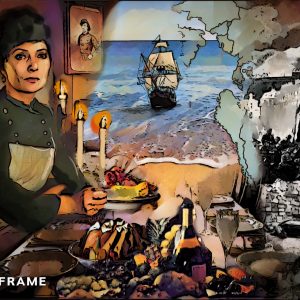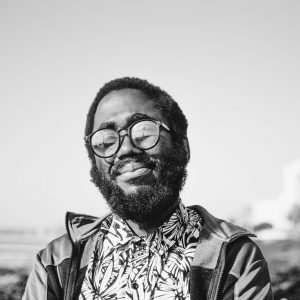Making meaning and art from forced migration
Serge Nitegeka’s new exhibition Lost and Found confronts the viewer with the problem of forced migration. A look at one art form demands that you look at the other. Only then is meaning glimpsed.
Author:
24 February 2021

Walking into Serge Alain Nitegeka’s new exhibition Lost and Found, a painting and sculpture, sharing a room, greet the viewer. In the painting, a charcoal-sketched man holds the top of a white, stitched and oblong bundle to his chest with one arm. He presses his face against it; his other arm holding the bundle further down its unwieldy structure. It is an intimate moment between two forms on canvas. In all the possible relationships the man has with the bundle, it is always precious – perhaps even delicate.
The first room of Lost and Found’s three-roomed exhibition contains its message in its most perceptively literal formulation, poetically expressed by British-Somali poet Warsan Shire’s words:
i want to go home,
but home is the mouth of a shark
home is the barrel of the gun
and no one would leave home
unless home chased you to the shore
Related article:
Forced migration is the central preoccupation Nitegeka grapples with in his work. His catalogue of exhibitions ventures beyond literal depictions of migratory experiences, into the nuanced territory of making meaning from them. In a few words, Nitegeka says his latest show is “about how identity is fragile and how on one level we identify ourselves through our objects. The things we make or the ideas of ourselves as baggage we carry, the accumulated memory, shame, unresolved feelings, experiences one has had, aspirations and broken dreams – it’s all there”.
For him, art speaks. Fluent in minimalism and abstraction, his latest work presents a refined and cogent message from the artist’s mind about the things which make us who we are. And from his heart, the viewer feels what a fragile set of relations, assignations, experiences, feelings and other features identity is.
Complicating seeing and making
The five mixed-media paintings and six sculptures which make up Lost and Found are shown in Johannesburg’s Stevenson Gallery. The paintings are made with charcoal and paint on wooden panels. It is a reference to the packing crates that Nitegeka used in his earlier work. The sculptures get their shape and texture from white canvas, tightly wrapped and stitched over forms that are simultaneously geometric and organic.
Though together in the first room, the paintings and sculptures are shown separately in the exhibition’s remaining two rooms. With this choice, the relationship between the art forms and their metaphorical roles in Nitegeka’s work is made nuanced and complex.
In the sparse environment of the painting room, each wooden canvas shows a character posed by Nitegeka, a bundle, an incomplete black circular form, the twin arrows and the “FRAGILE” signs often seen on packing crates. Nitegeka’s experimentation with mediums as diverse as wood, cement and audio is one of his trademarks. But his use of black is the fine skill on show here, after he dedicated a significant portion of his practice to studying black, its permutations and connotations.

From 2012 to 2018, Nitegeka had six solo exhibitions with the Stevenson Gallery, each an exploration of the various facets of black. Sitting on a tan coach at the gallery, he sips coffee from a square cup, both the drink and its vessel the colour of his obsession, and discusses the journey of his work.
“As an artist, when you start to investigate something, you start on a simple plane and you work your way up to complicated things. Rather than understand, it’s how you feel and how you work with a colour. How you feel about it and how it feels about you. The psychological underpinnings of that. From there, I’m able to work it through forms and start to attach metaphors and memories of lived experience. That’s kind of where it started,” Nitegeka says.
The literal beginnings of his journey as an artist, however, started in childhood play.
An early affinity
Serge Alain Nitegeka was born in Rwanda in 1983, with what he describes as an “affinity” for art. He has channeled this affinity, from an early age, through sculpture, drawing and painting. “My fondest memory of making an object, maybe the first sculpture,” he says, “was when it had just rained. We would take the mud and try to shape a car out of it. We used to find a very smooth slab on someone’s stoep and bash and bash and bash, shaping something out. At the end you had this beautiful thing.”
During the civil war in Rwanda, the Nitegeka family – mother, father and four children – fled into what was then Zaire. Of their flight, Nitegeka says, “But while we were crossing the border we lost hold of each other. For some weird miracle, unexplainable circumstance we found each other again.” The family would live in a refugee camp in the city of Goma. Nitegeka’s mother, who worked for the United Nations Development Programme, took a scouting trip to Kenya before returning for her family.
Once in Kenya, Nitegeka enrolled at Dagoretti High School. Here, he took art and design classes. He and classmates made art from traditional materials as well as with calabash, bamboo, dry banana leaf and whatever else was at hand. After finishing high school, moving to Johannesburg and enrolling for Fine Arts at the University of the Witwatersrand, Nitegeka realised in his first lectures that he needed to build a theoretical knowledge that would match his skills.
With little money to live off, let alone buy art materials with, he returned once again to working with found materials. A recycling depot at the west of the main university campus became a treasure trove for the young artist. One night, a friend tipped him off about packing crates which lay for the taking somewhere on campus. It was through working with those crates that the theme of forced migration – which Nitegeka had until then avoided – became central to his work. The metaphors of this material and his own experience began to unravel then.
Related article:
“I’m sitting with these crates in our shared studio, things start coming to me and I start drawing on it with charcoal. And then I took all sorts of things to it, I had grinders, chisels, hammers, painted on it. Different ways to make a mark. But it was just one single form that I was playing around with. I didn’t know where it was going. Slowly, at a metaphorical level, I started to weave a narrative around charcoal and wood both being the same thing, just at different stages. I was drawing myself nude at the time, stripped bare, no clothes.”
Clothes are material possessions and signifiers of sensibility among other things. Nitegeka as the character in his paintings makes the point that even when one is stripped of all that is worldly, one’s fragile identity is still a possession and burden.
His nudity also alludes to lack as a state in itself. He says this about what the migratory experience strips one of: “It’s an experience where you don’t have any choices. We always have something, in your hand or on you, in your pocket. Even not-having is having something because it’s pointing to the lack of that something. There is no nothing-nothing because nothing exists.”
Complicating thinking and seeing
Nitekega asks us to complicate our ways of seeing and thinking about migration in Lost and Found – particularly in the way he plays with site and sight.
In the sculpture room, the bundles depicted in the exhibition’s paintings all sit on platforms at varying heights from the ground. Only among themselves, they create an initial sense of bathos: now only representations of bundles that people forced into migration might use to contain all they have or can carry just until safety. They look heavy, not shaped to be wieldy and put back together along lines of stitching.
As the viewer gazes at the sculptures at a downward angle, metaphors abound about the way migration is viewed. But what creates the artistic moment with a bundle devoid of its context and consequence is to look up and see, in the painting room, the bundle heavy with the meanings poured into it by the person who must carry it.
This play on the viewer’s line of sight between the sculptures and paintings shines a light on forced migration. This it does by allowing the viewer, taking each image in turn, to form meaning from experience. Each artform is inextricable from the other, as we are too – regardless of the borders and identities that appear to say otherwise.

Concerning minimalism
Lost and Found is not, according to the artist, a move away from the minimal abstraction that defined his work after studying, but instead a way of softening its language and making it more universally comprehensible. The exhibition is Nitegeka’s most overt personal account of forced migration. With it, he trades the open-endedness of minimal abstraction for the cool clarity of a minimal realism.
Today, the idea of minimalism – away from the artistic movement that gained prominence in the 1960s – conjures the images of Marie Kondo and other celebrated disavowers of material possession. But the minimalism forced on certain people on the move in migration is neither a choice nor very often a slow, reflective process.
“There is a kind of minimalism in forced-migration subjects,” says Nitegeka, “Minimalism has a lot to do with stripped-down quietness. It’s usually about one thing, not many things. There’s no clutter. This is the way of life of most refugees, displaced people and asylum seekers – it’s survival. Distilled down to almost primal level. There are no choices in what you can eat, it’s what you can find, what you can make do with. That’s where the minimal can be found if we’re talking about art and making meaning out of that.”
Finding meaning and ourselves
Together, the sculptures and paintings of Lost and Found ask how essential certain parts of ourselves are. They ask how we can arrive at safer spaces but still recognise ourselves. Art created as a continual process of finding and making meaning from and with the experiences of migration presents a challenge to those who look and want to speak about this important feature of not only the art world but the globalised world too.
Nitegeka’s uniquely informed perspective paired with a highly philosophical approach and masterful execution with materials, sets his message apart from other artists working with similar themes in its clarity and potency.
Sparse as his latest work already is, Nitegeka strives for even less. With this minimalism, he hopes to say even more about the forced migration of people and what meanings those experiences are pregnant with.
“A quest that I’ve had somewhere subconsciously at the back of my head is to somehow, one day, draw a line in a gallery and that’s a show. And people will be able to feel the power of that line that I have distilled over four decades of work. I have done and travelled massive installations but somewhere in my practice I have a line and that line is powerful.”


